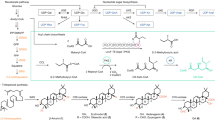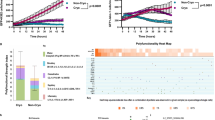Abstract
We have cloned the light and heavy chain cDNAs for the humanized monoclonal antibody Campath-1H and expressed them in Chinese hamster ovary (CHO) cells using a dihydrofolate reductase (dhfr) amplification procedure. Each cDNA was positioned under control of the strong human β-actin promoter/polyaden-ylation signals and used to evaluate alternative vector design and amplification procedures. By employing a dual selection co-transfection strategy, initial transfor-mants accumulated antibody levels of 0.5 μg/ml after 4 days continuous culture. When subjected to successive rounds of selection in medium containing stepwise increments in methotrexate (MTX), stable cell lines were obtained that secreted up to 200 μg/ml of Campath-1H during the same period. This reflects a productivity of l00 μg/106 cells/day and demonstrates the potential of engineering CHO cells for the production of recombinant antibodies.
This is a preview of subscription content, access via your institution
Access options
Subscribe to this journal
Receive 12 print issues and online access
$209.00 per year
only $17.42 per issue
Buy this article
- Purchase on Springer Link
- Instant access to full article PDF
Prices may be subject to local taxes which are calculated during checkout
Similar content being viewed by others
References
Hale, G., Xia, M.-Q., Tighe, H.P., Dyer, M.J.S. and Waldmann, H. 1990. The Campath-1H antigen (CDw52). Tissue Antigens 35: 118–127.
Hale, G., Hoang, T., Prospero, T., Watt, S.M. and Waldmann, H. 1983. Removal of T cells from bone marrow for transplantation: comparison of rat anti-lymphocyte antibodies of different isotypes. Mol. Biol. Med. 1: 305–319.
Hale, G., Cobbold, S.P., Waldmann, H., Easter, G., Matejtschuk, P. and Coombs, R.A. 1987. Isolation of low frequency class switch variants from rat hybrid myelomas. J. Immunol. Meth. 103: 59–67.
Hale, G., Cobbold, S. and Waldmann, H. 1988. T-cell depletion with Campath-1 in allogeneic bone marrow transplantation. Transplantation 45: 753–759.
Dyer, M.J.S., Hale, G., Hayhoe, F.G.J. and Waldmann, H. 1989. Effect of Campath-1 antibodies in vivo in patients with lymphoid malignancies: Influence of antibody isotype. Blood 73: 1431–1439.
Reichmann, L., Clark, M., Waldmann, H. and Winter, G. 1988. Reshaping human antibodies for therapy. Nature 322: 323–327.
Hale, G., Dyer, M.J.S., Clark, M.R., Phillips, J.M., Marcus, R., Reichmann, L., Winter, G. and Waldmann, H. 1988. Remission induction in non-Hodgkin lymphoma with the reshaped human monoclonal antibody Campath-1H. Lancet 2: 1394–1399.
Weidle, U.H., Koch, S. and Buckel, P. 1987. Expression of antibody cDNA in murine myeloma cells: possible involvement of additional regulatory elements in transcription of immunoglobulin genes. Gene 60: 205–216.
Nakatani, T., Nomura, N., Horigome, K., Ohtsuka, H. and Noguchi, H. 1989. Functional expression of human monoclonal antibody genes directed against pseudomonal endotoxin A in mouse myeloma cells. Bio/Technology 7: 805–810.
Gillies, S.D., Dorai, H., Wesolowski, J., Majeau, G., Young, D., Boyd, J., Gardner, J. and James, K. 1989. Expression of human anti-tetanus toxoid antibody in transfected murine myeloma cells. Bio/Technoloey 7: 799–804.
Kaufman, R.J., Wasley, L.C., Spilotes, S.D., Gossels, S.D., Latt, S.A., Larsen, G.R. and Kay, R.M. 1985. Coamplification and coexpression of human tissue type plasminogen activator and murine dihydrofolate reductase sequences in Chinese hamster ovary cells. Mol. Cell. Biol. 5: 1750–1759.
Zettlmeissl, G., Ragg, H. and Karges, H.E. 1987. Expression of biologically active antithrombin III in Chinese hamster ovary cells. Bio/Technology 5: 720–725.
Weidle, U.H., Borgya, A., Mattes, R., Lenz, H. and Buckel, P. 1987. Reconstitution of functionally active antibody directed against creatine kinase from separately expressed heavy and light chains in non-lymphoid cells. Gene 51: 21–29.
Feys, V., De-Waele, P., Van De Voorde, A., Casneuf, P. and Fiers, W. 1988. Expression of functional mouse antibodies directed against the tumour marker human placental alkaline phosphatase in non-lym-phoid cells. Int. J. Cancer 2: 26–27.
Gunning, P., Leavitt, J., Muscat, G., Ng, S.-Y. and Kedes, L. 1987. A human β-actin expression vector system directs high-level accumulation of antisense transcripts. Proc. Natl. Acad. Sci. USA. 84: 4831–4835.
Law, M.-F., Byrne, J.C. and Howley, P.M. 1983. A stable bovine papilloma hybrid plasma that expresses a dominant selective trait. Mol. Cell. Biol. 3: 2110–2115.
Huynh, T., Young, R. and Davies, R. 1984. Construction and screening of cDNA libraries in λgt10 and λgt11, p. 49–78. In: DNA Cloning, Vol 1: A Practical Approach. Glover, D. (Ed.). IRL Press, Oxford.
Subramani, S., Mulligan, R. and Berg, P. 1981. Expression of the mouse dihydrofolate reductase complementary deoxyribonucleic acid in Simian Virus 40 vectors. Mol. Cell. Biol. 1: 854–864.
Mellon, P., Parker, V., Gluzman, Y. and Maniatis, T. 1981. Identification of DNA sequences required for transcription of the human α1-globin gene in a new SV40 host-vector system. Cell 27: 279–288.
Urlaub, G. and Chasin, L.A. 1980. Isolation of Chinese hamster cell mutants deficient in dihydrofolate reductase activity. Proc. Natl. Acad. Sci. USA. 77: 4216–4220.
Gorman, G. 1985. High efficiency gene transfer into Mammalian cells, p. 143–190. In: DNA Cloning, Vol. II. Glover, D. (Ed). IRL Press, Oxford.
Author information
Authors and Affiliations
Rights and permissions
About this article
Cite this article
Page, M., Sydenham, M. High Level Expression of the Humanized Monoclonal Antibody CAMPATH-1H in Chinese Hamster Ovary Cells. Nat Biotechnol 9, 64–68 (1991). https://doi.org/10.1038/nbt0191-64
Received:
Accepted:
Issue Date:
DOI: https://doi.org/10.1038/nbt0191-64
This article is cited by
-
A BioDesign Approach to Obtain High Yields of Biosimilars by Anti-apoptotic Cell Engineering: a Case Study to Increase the Production Yield of Anti-TNF Alpha Producing Recombinant CHO Cells
Applied Biochemistry and Biotechnology (2018)
-
Using simple models to describe the kinetics of growth, glucose consumption, and monoclonal antibody formation in naive and infliximab producer CHO cells
Cytotechnology (2016)
-
Production of anti TNF-α antibodies in eukaryotic cells using different combinations of vectors carrying heavy and light chains
Cytotechnology (2015)
-
The relationship between mTOR signalling pathway and recombinant antibody productivity in CHO cell lines
BMC Biotechnology (2014)



